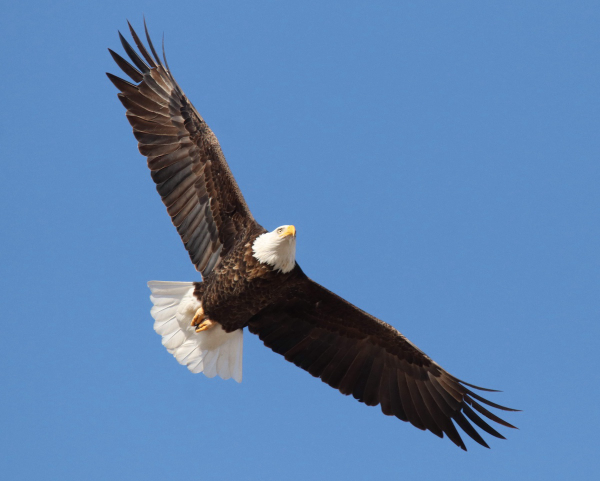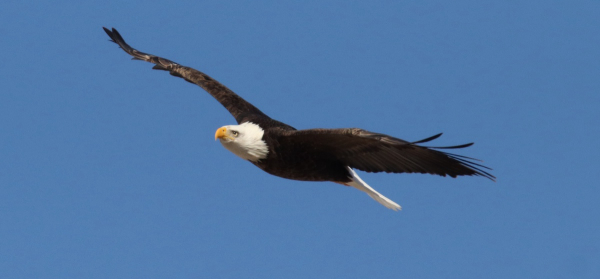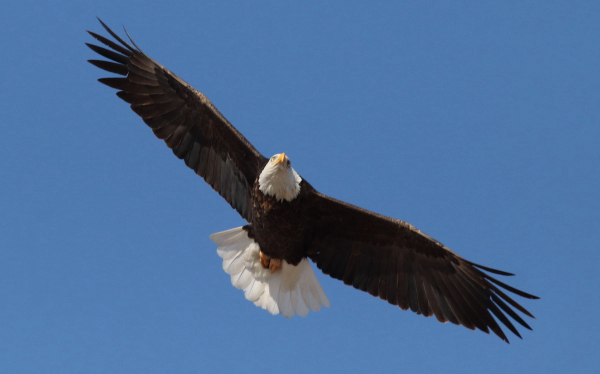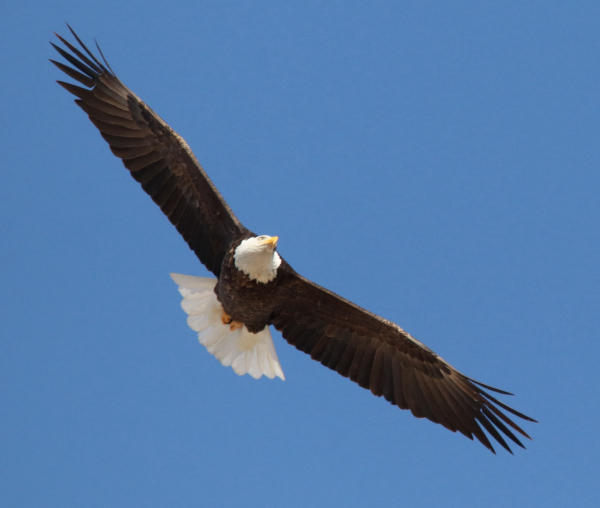During mid-January it’s no surprise that it’s cold with a minimum of birds on hand in the open plains of North Dakota. I actually tried a couple birding drives last week that registered no birds as we registered our coldest temperatures (down to –22) with the strongest winds (to 40mph) and crazy cold wind chills (to –48): Yikes! With a beautifully sunny morning at hand last Thursday and the thermometer holding at +11, I felt a great need to check the best areas to the south and east for Rough-legged Hawks and began what turned out to be a 36 mile drive one way. I was anxious to give my camera a workout, and I don’t doubt my camera and lens needed some action too.

The drive looked promising, but not a feather stirred. I reluctantly reversed my course and pondered taking an alternate route home, but decided this was my best bet – I should double-down and retrace my track. Three miles beyond the potential alternate turn, I was alerted by what looked like wings above the short grass adjacent to the road. My first thought was a Northern Harrier, but better yet, it was a Short-eared Owl flying low, just 5 feet above ground on a hunt. I hoped to position in front of the owl’s apparent route with the sun at my back, but the owl turned into a large field of tall grass where Rough-legged Hawks were active during late winter 2 years before.

I thought the owl might circle back toward the road, or near an adjacent road the led north, but suddenly the owl disappeared – a tactic I’ve been all too familiar with this winter – but all it had to do was dive into the 4 feet tall grassland after prey or to rest and it’s out of sight. I spent some time waiting for the owl to reappear somewhere in the area, but no luck. I continued retracing my original route, zooming up the high escarpment that divides the Missouri Coteau and the Drift Plain geologic areas, and 2 miles into the Coteau I found a big flock of about 30 Horned Larks. They didn’t offer a close approach, but they made me rethink leaving the owl location, so I drove the 4 miles back to see if the owl reappeared.
I drove along the edge of the tall grassland, turned back with seeing an owl or any other birds, but about a mile ahead an eagle flew into view. It turned to fly above the road as if it was watching for roadkill carrion or potential prey by my estimate. I was already following the impressive adult Bald Eagle and became hopeful for a photo opportunity as it crossed the road, but at that point it made a beeline for a big cottonwood on the wrong side of the road for me to take anything but silhouette photos with the sunlight beaming behind the big raptor.

Kind of desperate for a photo op, I figured I’d spend a bit more time in the area with an eagle and an owl on hand. After all, they were the first birds I’ve seen in about a week, aside from the afore-mentioned Horned Larks and a flock of 14 Sharp-tailed Grouse the day before. I swung by the tall grassland again, and when I took a 180-degree turn around, there was the Bald Eagle soaring ever-higher above the road, headed kinda north. I rushed west, but realized the eagle was now winging fast in my direction! Expecting a quick flyby, I pulled my car over, stopped, and hopped out the door with my camera.
At first I had a little trouble locating the eagle through my lens, but as I fumbled a moment the eagle slipped into a circular flight and began to soar – right in front of me! Woo-wee, what luck as the impressive eagle was winging on expansive wings in fairly tight circles, seemingly unconcerned or uninterested in the white car or the blue-coated animal pointing a black camera lens at it. I was thrilled, not only by the stunning bird, but by the bright winter sun illuminating it with a clear deep blue sky as background. By the time it started its third circle, the grand eagle was directly overhead – how exciting!

As it reached the east side of that circle it resumed its glide to the east, and that’s when I automatically raised my right fist high and cried “Hoka Hey Brudda,” a call I like to share with abiding eagles – Golden and Bald. Hoka Hey is a native Lakota word for “Let’s do it,” or “Let’s go!” For me, it’s a historic call to acknowledge an exciting opportunity to photograph an eagle – a shared experience the eagles provide, and sometimes they are interested in checking me out too.
But wait, the big Bald was still coursing the north side of the road, so I hopped in my car, reversed my direction, and hustled down the road. I expected the eagle was headed for a lone sentinel cottonwood tree that eagles seem to be attracted to, but it suddenly began circling again. As soon as I was in position I began photographing again, and this time the eagle seemed to acknowledge me. I also tried a little different photo technique, and rather than my usual attempts to anticipate when to take a photo, then another, and another as the bird circled, I used the Al Servo tech option and held the shutter button down for a couple seconds at key points of the eagle’s circling flight.


The camera took a series of up to 7 photos per second as long as I depressed the shutter button. It’s always exciting to hear the shutter rattling like that, and there is less of a chance you will miss a special image – usually. As the eagle crossed the road and became a silhouette again, it vanished into the sun to the south, and I never saw it again. Hoka Hey my brother! At that point I headed back toward my office, thrilled to have such an exciting interaction with a spectacular bird. On the way, I saw a small flock of 7 Snow Buntings after topping the escarpment, but nothing more over the next 22 miles.
There is one tech footnote though: As I was reviewing my photos that evening, I was thrilled with the first images from the first soaring flight, but during the second soaring episode, when I used the Al Servo technique, the resulting photos were not in focus – every one was blurred; dang. Apparently the autofocus (AF) was out of sync; or I didn’t have the eagle in focus as I pressed the shutter button for several seconds a couple times – darn. Either way, I’m thrilled the first series of photographs turned out with the sunlight and blue sky creating the basis for perfectly sharp images of the eagle in action. Plus, the eagle was sooo cooperative: Lucky me!

I certainly hope you have some good luck photographing birds soon, maybe tomorrow, this weekend, or whenever you have a chance to give your camera a workout next. And remember, it only takes one bird to make your day, or even your week!
Article and Photographs by Paul Konrad
Share your bird photos and birding experiences at editorstbw2@gmail.com